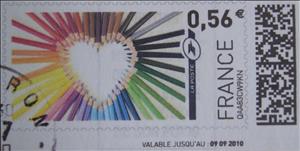Stamp: Heart design made from coloured pencils (France 2010)
Heart design made from coloured pencils (France 2010)
01 January (France ) within release MonTimbrEnLigne. Art goes into circulation Stamp Heart design made from coloured pencils face value 0.90 Euro
| Stamp Heart design made from coloured pencils in catalogues | |
|---|---|
| Colnect codes: | Col: FR-TIM 2010-179 |
Stamp is square format.
Also in the issue MonTimbrEnLigne. Art:
- Stamp - Abstract art in red and yellow face value 0.56;
- Stamp - Freedom Peace Dove. Liberte face value 0.56;
- Stamp - Abstract Art of Woman with Musical rabbit face value 0.56;
- Stamp - Carnaval Mask face value 0.56;
- Stamp - Colourful Swirl Painting face value 0.56;
- Stamp - Enamel clover leaf face value 0.56;
- Stamp - Flower Painting face value 1.35;
- Stamp - Four leaved clover pattern face value 0.90;
- Stamp - Framed Cloud face value 0.90;
- Stamp - Heart design made from coloured pencils face value 0.90;
- Stamp - Four coloured gloves face value 0.56;
- Stamp - Carnaval Mask in black face value 0.56;
Stamp Heart design made from coloured pencils it reflects the thematic directions:
Art is a diverse range of human activities in creating visual, auditory or performing artifacts (artworks), expressing the author's imaginative or technical skill, intended to be appreciated for their beauty or emotional power. In their most general form these activities include the production of works of art, the criticism of art, the study of the history of art, and the aesthetic dissemination of art. The oldest documented forms of art are visual arts, which include creation of images or objects in fields including painting, sculpture, printmaking, photography, and other visual media. Architecture is often included as one of the visual arts; however, like the decorative arts, or advertising, it involves the creation of objects where the practical considerations of use are essential—in a way that they usually are not in a painting, for example. Music, theatre, film, dance, and other performing arts, as well as literature and other media such as interactive media, are included in a broader definition of art or the arts. Until the 17th century, art referred to any skill or mastery and was not differentiated from crafts or sciences. In modern usage after the 17th century, where aesthetic considerations are paramount, the fine arts are separated and distinguished from acquired skills in general, such as the decorative or applied arts.
The heart is a muscular organ found in most animals. This organ pumps blood through the blood vessels of the circulatory system.The pumped blood carries oxygen and nutrients to the body, while carrying metabolic waste such as carbon dioxide to the lungs.In humans, the heart is approximately the size of a closed fist and is located between the lungs, in the middle compartment of the chest, called the mediastinum.
Originally, the term 'stationery' referred to all products sold by a stationer, whose name indicated that his book shop was on a fixed spot. This was usually somewhere near a university, and permanent, while medieval trading was mainly carried on by itinerant peddlers (including chapmen, who sold books) and others (such as farmers and craftsmen) at markets and fairs. It was a unique term used between the 13th and 15th centuries in the manuscript culture. Stationers' shops were places where books were bound, copied, and published. These shops often loaned books to nearby university students for a fee. The books were loaned out in sections, allowing students to study or copy them, and the only way to get the next part of the book was to return the previous section



